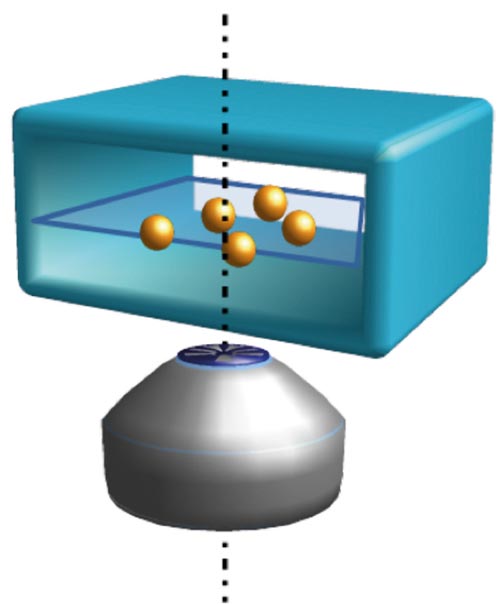Hazel, birch or grass? – Distinguish pollen using microfluidics and neuronal networks

The patented design of the microfluidic channels allows to align all particles in the focal plane. Source: A. Kleiber/Leibniz-IPHT
Up to 1000 pollen per second flow by the optical window in a narrow channel on the stamp sized chip. A digital camera captures each of the tiny single grains through a microscope lens.
To receive sharp shots for the following data processing, every analyzed particle has to pass the liquid channel in the focal plane of the lens. The height of the focal plane of the used high-resolution lenses measures less than a hundredth millimetre.
Scientists of Leibniz IPHT met this technological challenge employing a sophisticated design of the components in the microfluidic chip. The patented method enables them to align the pollen grains exactly in the focal plane and therefore to obtain sharp images of all objects.
“Using two liquid streams from the sides, we press the particle stream to a sheet, just like a nozzle. A new arrangement of the micro channels rotates the sheet by 90° into the focal plane,“ explains Andreas Kleiber the technology. in the scope of his PhD thesis, the scientist researches methods for the high-throughput-analysis of bioparticles using microfluidic chips.
The principle of hydrodynamic focusing is already known in the field of flow cytometry for the analysis of cell populations. Here, the cells are focused in a way that they pass by the measurement window along a line. “New to our system is, that we arrange the particles in a thin, two dimensional lamella, and therefore use the whole frame of the camera. This makes the method so rapid“, says Kleiber.
The researchers can actuate the horizontal position and thickness of the particle layer accurately. Therefore, they are able to control the rotation of the pollen in the stream. “Using methods already known from computer-tomography we are able to produce 3D-image data that contain important information e.g. about the three-dimensional morphology of a pollen grain.
The 3D-information improves the reliability of the pollen identification significantly“, elucidated Kleiber. The researcher evaluates images of the different pollen with software tools for particle tracking and feature extraction. A pre-trained convolutional neuronal network classifies the shots to a certain kind of pollen by means of the extracted data. The hit rate is above 98%.
The researchers classified the pollen, which originate from the research group Indoor Climatology at the University Hospital Jena, without any additional label, solely on basis of the image information from microscopy. “We are able to use the method furthermore for the analysis of cells e.g. to distinguish subtypes of white blood cells“, underlines Dr. Thomas Henkel, who leads the relevant research work at Leibniz IPHT.
“In the future, it should be possible to sort bioparticles with our chip“, says Henkel about the planned research, which is funded by the EU in the range of the Era-NET-DLR project “WaterChip“.
Andreas Kleiber
Work Group Microfluidics//Leibniz IPHT Jena
Andreas.Kleiber(a)leibniz-ipht.de
+49 (0) 3641 206-357
Dr. Thomas Henkel
Work Group Leader
Thomas.Henkel(a)leibniz-ipht.de
+49 (0) 3641 206-307
https://www.leibniz-ipht.de/en/institute/presse/news/detail/hasel-birke-oder-gra…
http://www.e-smi.eu/index.php?id=topim-tech-20180
http://waterchip.eu
Media Contact
All latest news from the category: Life Sciences and Chemistry
Articles and reports from the Life Sciences and chemistry area deal with applied and basic research into modern biology, chemistry and human medicine.
Valuable information can be found on a range of life sciences fields including bacteriology, biochemistry, bionics, bioinformatics, biophysics, biotechnology, genetics, geobotany, human biology, marine biology, microbiology, molecular biology, cellular biology, zoology, bioinorganic chemistry, microchemistry and environmental chemistry.
Newest articles

NASA: Mystery of life’s handedness deepens
The mystery of why life uses molecules with specific orientations has deepened with a NASA-funded discovery that RNA — a key molecule thought to have potentially held the instructions for…

What are the effects of historic lithium mining on water quality?
Study reveals low levels of common contaminants but high levels of other elements in waters associated with an abandoned lithium mine. Lithium ore and mining waste from a historic lithium…

Quantum-inspired design boosts efficiency of heat-to-electricity conversion
Rice engineers take unconventional route to improving thermophotovoltaic systems. Researchers at Rice University have found a new way to improve a key element of thermophotovoltaic (TPV) systems, which convert heat…



